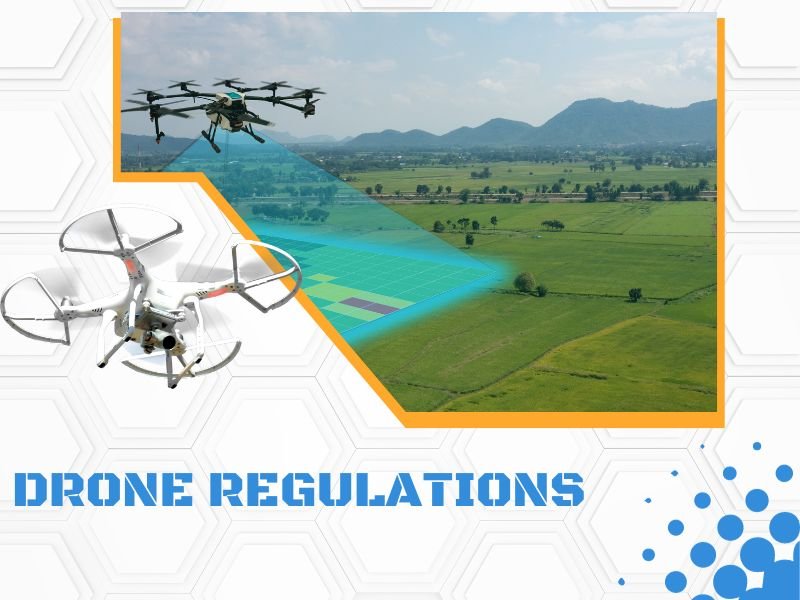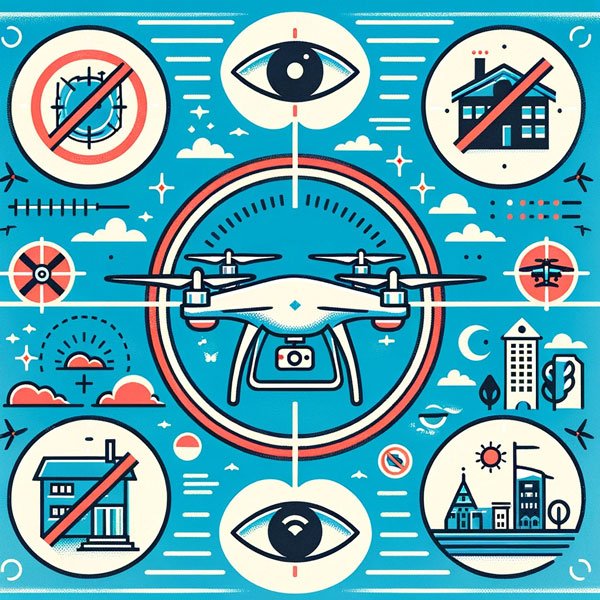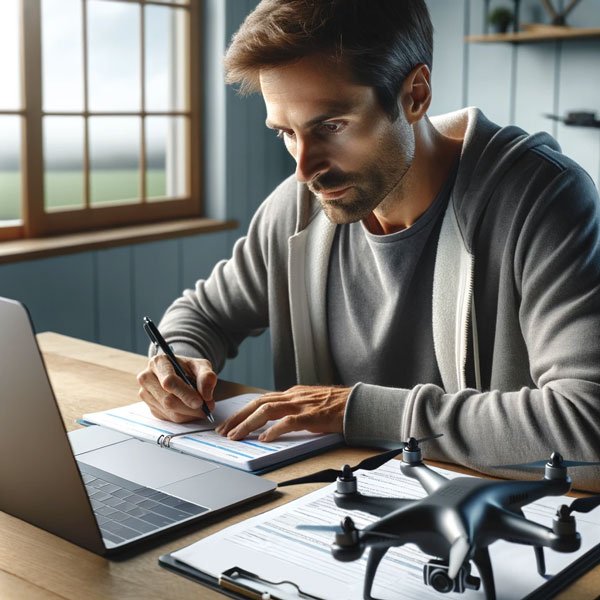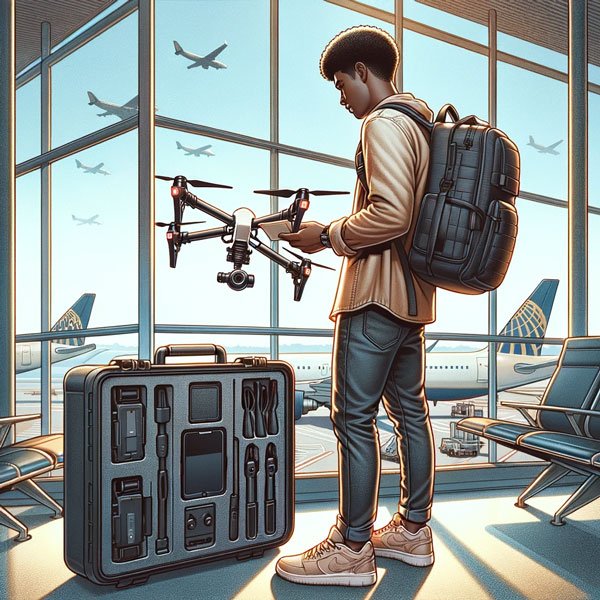Drones have revolutionized the way we capture breathtaking aerial views, deliver packages, and even conduct search and rescue missions.
These marvels of technology have soared through the skies, bringing convenience and innovation to our daily lives.
However, with their increasing popularity and capabilities, concerns have arisen about safety, privacy, and the need for regulations.
In this article, we will delve into the ever-evolving world of drone regulations, unraveling the complexities and exploring what every drone enthusiast needs to know.
So fasten your seatbelts and prepare for a deep dive into the fascinating realm of drone regulations.
Table of Contents
- Understanding the Basics: A Guide to Drone Regulations
- How to Register Your Drone: Step-by-Step Process Explained
- Flying Safely and Legally: Tips for Complying with Drone Regulations
- Navigating Restricted Areas: Where Can You Fly Your Drone?
- Drone Insurance: Do You Need It and What Does it Cover?
- Keeping Up with the Latest Updates: Staying Informed on Drone Regulations
- International Travel with Drones: Guidelines and Restrictions
- FAQs About Drone Regulations
- Final Words
Understanding the Basics: A Guide to Drone Regulations
In this section, we will explore the essential information you need to know about drone regulations.
Drones have become increasingly popular in recent years, and as a result, governments around the world have implemented regulations to ensure their safe and responsible use.
Understanding these regulations is crucial for drone enthusiasts, both for their own safety and to avoid any legal consequences.
What are drone regulations?
Drone regulations are rules set by government authorities to control the operation and usage of drones.
These regulations aim to ensure the safety of people, property, and airspace, while also addressing privacy concerns.
Although the specifics of drone regulations vary from country to country, there are some common elements that most regulations cover.
These include registration requirements, operating restrictions, flight guidelines, and penalties for non-compliance.
The importance of knowing drone regulations
As a drone owner and operator, it is your responsibility to familiarize yourself with the relevant regulations in your jurisdiction.
Ignorance of the law is not a valid excuse, and violating drone regulations can result in fines, confiscation of your drone, or even criminal charges in severe cases.
Understanding the basics of drone regulations will help you fly your drone safely, avoid legal troubles, and contribute to the positive reputation of the drone community as a whole.
It’s important to note that drone regulations are constantly evolving, and what may be allowed today might not be the case tomorrow.
So, make sure to stay up-to-date with any changes or updates to the regulations to ensure you are flying legally and responsibly.
Knowing the basics of drone regulations sets the foundation for your drone flying journey.
It’s crucial to have a solid understanding of the rules and guidelines that apply to drones in your area to ensure both your own safety and the safety of those around you.
In the following sections, we will delve deeper into specific aspects of drone regulations, including the registration process, flying safely, navigating restricted areas, and more.
How to Register Your Drone: Step-by-Step Process Explained
In this section, we will walk you through the step-by-step process of registering your drone.
The registration process is an essential requirement imposed by many countries to ensure the responsible and safe use of drones.
Let’s dive into the process and get you up to speed on how to register your drone.
Step 1: Familiarize yourself with the regulations
Before registering your drone, it’s crucial to understand the specific regulations and guidelines set by your country or region.
These regulations may vary and could include age restrictions, weight limits, and designated flight zones.
By familiarizing yourself with these rules, you can ensure that you meet all the eligibility criteria for registering your drone.
Step 2: Gather the required information
Once you have familiarized yourself with the regulations, gather all the necessary information that may be required for the registration process.
This information typically includes your personal details, contact information, and drone specifications such as the make, model, and serial number.
Make sure to double-check the accuracy of the information to avoid any discrepancies during the registration process.
Step 3: Register online
Many countries provide online registration platforms to streamline the process. Visit the official website designated for drone registration in your country or region.
Fill out the online registration form, providing all the required information accurately.
Some countries may require you to pay a registration fee, while others may offer free registration.
Ensure that you complete all the mandatory fields and follow any provided instructions to successfully register your drone.
Step 4: Obtain your registration certificate
Once you have completed the online registration process, you will typically receive a registration certificate or identification number.
This certificate serves as proof of registration and may need to be carried with you whenever you fly your drone.
Remember to keep a copy of the certificate in case you need to provide it as evidence of compliance with regulations.
Step 5: Renew your registration if necessary
Some countries require drone registration to be renewed periodically.
Make a note of the expiration date of your registration and ensure that you renew it as per the guidelines provided by your country.
Neglecting to renew your registration could lead to penalties or restrictions on drone usage.
By following these step-by-step instructions, you can successfully complete the drone registration process and ensure compliance with the regulations in your country or region.
Remember, registering your drone is not only a legal requirement but also a responsible step towards promoting the safe and responsible use of drones.
Flying Safely and Legally: Tips for Complying with Drone Regulations
In this section, we will discuss some essential tips to ensure you fly your drone safely and in compliance with the regulations enforced.
Flying a drone can be an enjoyable and rewarding experience, but it is crucial to prioritize safety and adhere to the rules set by the authorities.
By following these guidelines, you can fly with confidence and minimize the risk of accidents or legal consequences.
Understand the Regulations
Familiarize yourself with the drone regulations specific to your country or region.
These regulations may include altitude limits, no-fly zones, and restrictions regarding privacy, residential areas, or airports.
By being aware of the rules, you can avoid unintentional violations and ensure a safer flight.
Register Your Drone
Some regions require drone registration, so make sure to complete this process before your first flight.
The registration process usually involves providing your contact information, drone specifications, and a small fee.
Registration helps authorities track drones and promotes responsible drone usage.
Pre-Flight Checks
Before every flight, conduct a thorough pre-flight checklist.
Inspect your drone for any damage or loose parts, ensure the battery is fully charged, and check the propellers for any signs of wear or damage. It is advisable to calibrate your drone’s compass and perform a test flight in an open area to ensure everything functions correctly.
Be Mindful of Weather Conditions
Weather conditions can significantly impact your drone’s performance and safety.
Avoid flying in strong winds, rain, or foggy conditions as they can compromise your control over the drone and increase the risk of accidents.
Check the weather forecast beforehand and plan your flights accordingly.
Respect Privacy and Public Spaces
Always respect people’s privacy when flying your drone. Avoid capturing images or videos of people without their consent, especially in private areas.
Additionally, be mindful of public spaces and avoid causing disturbances or interfering with other people’s activities.
By following these tips, you can ensure a safer and more enjoyable flying experience while complying with drone regulations.
Remember, safety should always be your top priority, both for yourself and others around you.
Flying a drone can be an exciting and captivating experience, but it’s crucial to understand the regulations surrounding restricted areas.
Drone operators must be aware of where they can and cannot fly their drones to ensure compliance with the law and maintain safety for themselves and others.
In this section, we will discuss the key points to remember when navigating restricted areas.
1. No-Fly Zones
It is vital to familiarize yourself with the designated no-fly zones in your area.
These areas typically include airports, military installations, government buildings, and other high-security locations.
Violating these regulations can lead to severe penalties, including fines and even criminal charges.
Check with your local aviation authority or use online resources to find maps or apps that show restricted airspace zones.
2. Prohibited Areas
In addition to no-fly zones, certain areas may have specific restrictions imposed by local authorities or private property owners.
These could include national parks, wildlife sanctuaries, and private properties where photography or privacy laws apply.
Always research and respect these restrictions to avoid any legal consequences or conflicts with individuals.
3. Temporary Restrictions
It’s important to stay informed about temporary flight restrictions (TFRs) that may arise due to emergencies, special events, or other circumstances.
TFRs can limit drone operation in specific areas or during certain timeframes to ensure public safety.
Stay updated by checking the local aviation authority’s website or using apps that provide real-time airspace information.
4. Controlled Airspaces
Controlled airspaces are areas designated for commercial air traffic, which means flying your drone in these areas without proper authorization is strictly prohibited.
These areas primarily include the airspace surrounding airports, heliports, and airfields.
To fly in controlled airspace, you may need to get permission from the relevant aviation authority or obtain a Part 107 certification if you are flying commercially in the United States.
It is essential to understand that restrictions may vary from one region or country to another, so it’s crucial to research and adhere to the regulations specific to your location.
By respecting the restrictions and regulations surrounding restricted areas, you can enjoy flying your drone responsibly while ensuring the safety and privacy of others.
Remember, as a drone operator, it is your responsibility to stay informed and comply with all applicable laws and regulations.
Drone Insurance: Do You Need It and What Does it Cover?
Drone insurance is an essential consideration for any drone owner.
While it is not legally required in all jurisdictions, it is highly recommended to protect yourself and your investment.
Drone insurance offers financial coverage for various risks and liabilities associated with owning and operating a drone.
Understanding the key points of drone insurance can help you make an informed decision about whether you need it and what it covers.
One of the main reasons to consider drone insurance is liability coverage. Accidents happen, and if your drone causes damage to property or injures someone, you could be held responsible for the associated expenses.
Liability coverage typically includes property damage and bodily injury to third parties. Having insurance can give you peace of mind and protect you from potential financial hardships that may arise from such incidents.
Furthermore, drone insurance may also cover physical damage to your drone itself.
Whether it’s accidental damage or theft, insurance can help you recover the costs of repair or replacement.
This coverage becomes particularly important if you fly your drone in demanding environments or engage in commercial activities where the risks are higher.
It’s worth noting that insurance policies can vary significantly, so it’s crucial to carefully review the terms and conditions before purchasing a policy.
Some insurance providers may offer additional coverage options, such as equipment breakdown, personal injury, or invasion of privacy claims.
Understanding the specific coverage and exclusions will help you choose a policy that best suits your needs and budget.
In conclusion, while drone insurance might not be legally mandatory in all areas, it is highly advisable to consider it as a responsible and proactive drone owner.
Liability coverage and protection against damage or theft can provide valuable financial security.
Remember to evaluate different insurance options and choose a policy that adequately covers your specific needs and usage patterns.
Keeping Up with the Latest Updates: Staying Informed on Drone Regulations
In an ever-evolving field like drone technology, staying up to date with the latest regulations and guidelines is crucial for both hobbyists and commercial operators.
As new laws are introduced and existing rules evolve, it is essential for drone enthusiasts to stay informed to ensure safe and legal operations.
Here are a few tips on how to stay up to date with drone regulations:
1. Subscribe to Official News Sources
One of the simplest ways to stay informed about drone regulations is to subscribe to official news sources like the Federal Aviation Administration (FAA), the Civil Aviation Authority (CAA), or any relevant aviation regulatory body in your country.
These organizations often release official statements, guidelines, and updates regarding drone regulations.
By regularly checking their websites or subscribing to their newsletters, you can stay ahead of any changes that might affect your drone operations.
2. Participate in Online Communities
Another way to stay informed about drone regulations is to actively participate in online drone communities.
Joining forums and social media groups dedicated to drones allows you to interact with other drone enthusiasts and professionals, sharing knowledge and discussing current regulations.
Often, members of these communities will post updates or news articles related to drone regulations, helping you stay informed and ensuring compliance with the latest rules.
3. Attend Workshops and Conferences
Attending drone workshops, seminars, and conferences is an excellent way to stay informed about the latest updates in drone regulations.
These events often feature expert speakers, industry leaders, and regulatory authorities who provide valuable insights and clarifications on new or changing drone laws.
Additionally, networking with other attendees can help you gain valuable contacts and firsthand information about upcoming regulatory changes.
4. Follow Industry Influencers and Experts
Many industry influencers, bloggers, and experts maintain dedicated websites, blogs, or social media accounts where they share news, updates, and analysis about the drone industry.
Following these individuals can provide you with timely and in-depth information about the latest regulations and their potential impact.
Furthermore, they often offer tips and suggestions on how to navigate complex regulatory environments and ensure compliance with evolving rules.
By actively seeking out reliable information sources, participating in relevant communities, attending events, and following industry experts, you can stay informed on the latest updates in drone regulations.
Keeping up with the evolving rules is crucial for safe and legal drone operations, allowing you to enjoy the benefits of this exciting technology while avoiding any unnecessary penalties or legal issues.
Remember, regulatory compliance helps ensure the continued growth and acceptance of drones for both recreational and commercial purposes.
International Travel with Drones: Guidelines and Restrictions
When it comes to traveling internationally with your drone, it is important to be aware of the guidelines and restrictions in place to ensure a smooth and hassle-free experience.
Different countries have varying rules and regulations when it comes to bringing drones into their territories, and failure to comply with these regulations could result in serious consequences.
Here are some important factors to consider when traveling abroad with your drone.
Research the Drone Regulations of Your Destination
Before embarking on your international journey, take the time to research and understand the drone regulations of your destination country.
Each country has its own set of rules, including registration requirements, flight restrictions, and prohibited areas.
It is essential to familiarize yourself with these regulations to avoid any legal issues or setbacks during your trip.
Register Your Drone, If Required
Many countries have a mandatory drone registration process that travelers must complete before flying their drones within their borders.
This registration process typically involves providing personal and drone-related information, such as make, model, and serial number.
Some countries also require you to carry proof of registration while operating your drone. Make sure to check if the country you’re visiting requires drone registration and complete the process before your departure.
Understand Flight Restrictions and Prohibited Areas
Certain countries impose flight restrictions and areas where drones are strictly prohibited from flying, such as airports, military bases, and government buildings.
It is crucial to be aware of these restrictions and avoid flying your drone in prohibited areas to ensure safety and compliance with local laws.
You can check the aviation authority or civil aviation websites of your destination country for detailed information regarding restricted airspace and any other flight limitations.
Pack Your Drone Properly
When traveling with your drone, ensure that it is packed securely and follows the airline’s safety guidelines.
Consider investing in a sturdy and protective drone case to protect it from any potential damage during transit.
Additionally, remove the battery and pack it separately in your carry-on luggage, following the airline’s guidelines for lithium batteries.
Always keep your drone within your reach and never place it in checked baggage to avoid any mishaps or theft.
Remember, international drone regulations are constantly evolving, so it is crucial to stay updated on any changes or new restrictions that may occur.
Check official government websites or contact the embassy or consulate of your destination country for the latest drone regulations and guidelines.
By following these guidelines and respecting the laws of the countries you visit, you can enjoy a seamless and enjoyable drone experience while traveling internationally. Safe flight!
FAQs About Drone Regulations
1. What are the regulations for flying a drone?
Drone regulations vary by country, but typically involve registering your drone, obtaining pilot certification or license, following specific flight restrictions, maintaining a visual line of sight, and respecting privacy and safety guidelines.
2. Do you need a license to fly a drone?
In some countries, you may need a license or certification to fly a drone, especially if it weighs above a certain threshold.
However, many countries have exemptions or different rules for recreational and commercial drone use.
3. What are the restrictions for flying a drone near airports?
To ensure aviation safety, flying a drone near airports is highly regulated. In most cases, it is prohibited within a certain radius of an airport, and you may need permission from the appropriate aviation authority to fly in controlled airspace.
4. Can drones be flown at night?
Nighttime drone flights are generally restricted due to safety concerns, as visibility is significantly reduced.
However, some countries may allow night flights under specific conditions, such as obtaining special certification or using specific lighting equipment.
5. Are there rules regarding flying drones over people?
There are regulations regarding flying drones over people, particularly for safety reasons.
In some cases, it may be prohibited, unless you have prior authorization or fall under certain categories, such as using a lightweight drone or obtaining specific drone certifications.
Final Words
As drone usage continues to increase, it becomes crucial to understand and comply with drone regulations to ensure safe and responsible operations.
Since regulations may differ, it is essential to stay updated with your local laws and follow them diligently.
Operating drones responsibly helps foster a positive environment for aerial technology, promoting both safety and innovation.







